How Far Underground Can You Get A Cell Service
What do you exercise when your favorite cabin getaway is and so remote you can't get a good jail cell betoken? If you lot're Ciena's Al Lounsbury, you build your own mobile cell tower right on elevation of your cabin.
Al Lounsbury is based in Ciena's Ottawa Campus and is function of our Digital Marketing team.
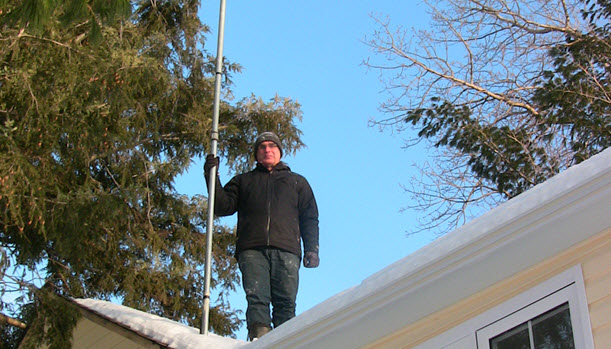
Practise yous have a special identify where you lot dear to relax and unwind, merely can't because of a lack of cell phone or mobile information coverage? Or maybe you're having problems getting good cell reception in your own home where your 2d role is located. For most people, the answer to these bug is to 'just deal with information technology' or endeavor switching providers. But every bit an gorging practise-it-yourselfer and an engineer, that wasn't my style. My solution was to build my own cell tower.
In my case, I accept a cabin in Northern Ontario. It's beautiful and peaceful there, but the nearest grocery store is 30 minutes away in a town with a population of less than 1,000 people. Cell coverage is spotty at best. If I'chiliad on peak of a hill on a articulate day, I might be able to pull in one bar on my mobile. In fact, many renters in the area have a daily walk to the top of a nearby hill merely to receive their text messages and emails.
So my engineering claiming was to figure out how to obtain not bad mobile coverage at my cabin, allowing me the occasional Friday piece of work day there versus existence in the office cube. Here's how I did it using common materials you can find online or at your local home improvement store.
Researching Your Needs
Step 1 in the process is to observe the nearest cell belfry to your location and figure out on what frequency band the tower operates on. Most 3G/4G systems operate in either the 800 (824 to 894) MHz or i.nine (1.85 to 1.99) GHz ring. The 800 MHz ring will have a greater range than the 1.ix GHz band due to atmospheric attenuation, hence many carriers prefer the 800 MHz ring for greater expanse coverage.
For my fellow Canadians, here's a great website which maps all the towers in Canada for multiple carriers and provides details, including their frequency band. You tin also cheque with your mobile carrier and enquire the technical back up department for the nearest tower and its frequency band. Additionally, you can search your telephone'south app store for "cell signal," and multiple apps will pop up that tin can help. On Android, I use the Open Signal app, which provides the direction of the nearest and strongest tower. In my example, the nearest Rogers cell tower is located in Bon Echo Provincial Park and operating at 850 MHz. With my enquiry done, it was time to move on to gearing up for the build.
Buying the Components You lot Need
Your basic listing of required components consists of a tower, an outdoor antenna, an indoor antenna, a bi-directional amplifier, and RF cables. For the best functioning, brand sure that your outdoor antenna is highly directional, essentially a narrow, laser-like beam that points directly to the nearest prison cell tower. By keeping the antenna highly focused, nosotros ensure that all the signal power is directed at our target belfry and not sprayed over a wide expanse. This is referred to as antenna gain and the higher the gain number the more than focused the antenna ability will be. The antenna I used is a xiii dbi proceeds 800 MHz Yagi antenna (fig. ane), found here.
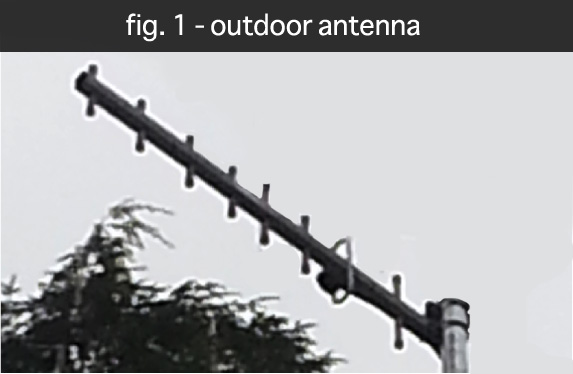 Side by side up is our indoor antenna. We want to maximize indoor coverage hence the gain number will exist much lower, equally we aim wide, not far. Too, to go along household peace with the lady of the business firm, installing an ugly antenna on the wall was "non" an option for me, just luckily a ceiling mountain was. By using a dual polarized (vertical & horizontal) ceiling mount antenna, y'all can provide 360-degree coverage around the antenna with a vertical beam width of 150 degrees downward from the antenna to the floor. The one I used (fig. 5, Part #301123) can be constitute hither.
Side by side up is our indoor antenna. We want to maximize indoor coverage hence the gain number will exist much lower, equally we aim wide, not far. Too, to go along household peace with the lady of the business firm, installing an ugly antenna on the wall was "non" an option for me, just luckily a ceiling mountain was. By using a dual polarized (vertical & horizontal) ceiling mount antenna, y'all can provide 360-degree coverage around the antenna with a vertical beam width of 150 degrees downward from the antenna to the floor. The one I used (fig. 5, Part #301123) can be constitute hither.
With both antennas in mitt, you'll need to pick out your bi-directional booster. With your booster, information technology'due south all about GAIN and ensuring the gain tin can be adjusted accordingly. In my example, I picked up a 55 db gain amplifier (fig. six, here). This worked perfectly and took my motel from no coverage to iv-5 bars of coverage in whatsoever conditions condition, including Snow! That said, if the budget allows for a higher gain amplifier, go for it. The college gain amplifier volition provide ameliorate coverage, including the ability to drive more than 1 indoor antenna if a wider indoor coverage expanse is needed.
We now have all the major components and merely need to connect everything together with good "low loss" RF cablevision since nosotros exercise non want to waste material precious indicate power with leaky loftier loss RF cables. A good depression loss 20-pes cablevision should accept a loss of one db or less. And yes, a single db is significant. To put in perspective, a 3 db loss ways that the point ability has been reduced by 50 percent…yes half! So every db counts, and ensuring 1 uses ultra-low loss cables is highly recommended if maximum coverage (gain) is needed.
Building the Tower
With our components in manus, we need to place our antenna placement locations. As the outdoor antenna is highly directional and the indoor antenna is basically focused direct downwardly beneath the outdoor antenna, we demand to ensure that the outdoor antenna does non point over the indoor antenna, allowing for roughly 15 feet of vertical separation. These separation requirements become much stricter if not-directional outdoor antennas are used with panel indoor antennas. In these cases, 20 feet vertical and 20 feet horizontal separation could be required to prevent RF feedback. This feedback is like to audio feedback that occurs when a microphone (inside antenna) gets as well shut to the output speakers (outdoor antenna). If feedback does occur, your amplifier will shut down, so make sure that you space each antenna carefully.
The tower itself is a unproblematic matter to build. And for me, a trip to Home Depot was all that was required. I used 1 ¼" galvanized pipage in 6 foot sections for the tower (fig. 3) and a shorter 4 foot ii" pipe (fig. ii) to ballast into the ground. Although steel pipe would be cheaper, information technology as well requires painting to ensure it does not rust, so I rejected that option.
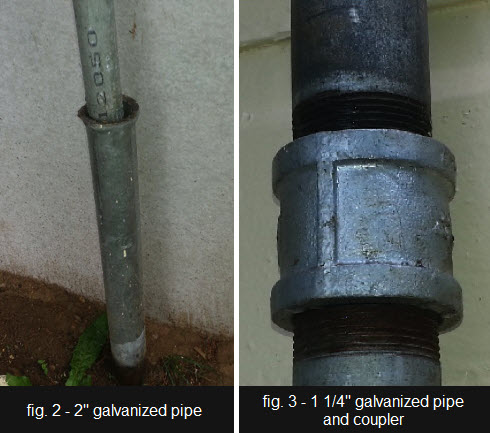 You'll demand to drive the ii" pipe into the footing with a sledgehammer or the back of an axe to allow the 1 ¼" pipe to slide into it as shown in figure 2. Infinite the pipe away from the home's foundation about the same altitude as the upper strap you'll use to secure the pole at the roof line. This will assistance ensure your tower is vertical and not leaning 1 way or the other. Having a directional antenna pointing 10 degrees downwardly or up would not exist good.
You'll demand to drive the ii" pipe into the footing with a sledgehammer or the back of an axe to allow the 1 ¼" pipe to slide into it as shown in figure 2. Infinite the pipe away from the home's foundation about the same altitude as the upper strap you'll use to secure the pole at the roof line. This will assistance ensure your tower is vertical and not leaning 1 way or the other. Having a directional antenna pointing 10 degrees downwardly or up would not exist good.
Later on securing your tower, attach the Yagi antenna to the 1 ¼" pole using the mounting hardware provided with the antenna. Don't forget to attach your ultra-depression loss cable and use electric record to strap the cable to the pole so wind does not crusade the cable to wear.
 To become the height you need, but add additional vi' pole sections from the bottom up using couplers (shown in figure iii) to push the antenna college while taping downward the cablevision on the side of the pole. By calculation sections to the bottom at ground level, you continue yourself off the roof. In my case I have five 6' sections holding up the antenna for a total tiptop from the ground of 30'. Use galvanized strapping (fig. 4) at the roofline to secure the pole into position so information technology does not fall or sway to one side or the other.
To become the height you need, but add additional vi' pole sections from the bottom up using couplers (shown in figure iii) to push the antenna college while taping downward the cablevision on the side of the pole. By calculation sections to the bottom at ground level, you continue yourself off the roof. In my case I have five 6' sections holding up the antenna for a total tiptop from the ground of 30'. Use galvanized strapping (fig. 4) at the roofline to secure the pole into position so information technology does not fall or sway to one side or the other.
At the roofline, find a identify (soffit vent or drill a hole) to feed the antenna cable into your attic/domicile and point the antenna roughly in the direction of the nearest cell tower. We'll fine-tune the placement later.
For the indoor antenna location, this is a adept fourth dimension to consult with your spouse, equally I did with the lady of my cabin. The only placement requirements are that it cannot be in the same vertical line as the outdoor antenna and should be about the indoor surface area where the coverage is needed near. And so the winning location for me was on the ceiling by the cabin'due south entrance as shown in effigy five.
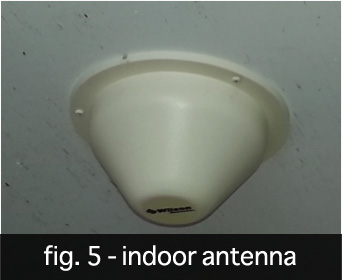 Now it's time to caput up to the cranium to mount the amplifier and connect all the RF cables. The amplifier should be placed in a convenient easy to access location in case maintenance is ever needed. I placed mine on a rafter that is right beside the attic hatch as shown in figure 6.
Now it's time to caput up to the cranium to mount the amplifier and connect all the RF cables. The amplifier should be placed in a convenient easy to access location in case maintenance is ever needed. I placed mine on a rafter that is right beside the attic hatch as shown in figure 6.
In order to minimize power consumption, I turned the gain of the 1.9 GHz band as low as possible since I didn't need any 1.nine GHz power. I then maximized the gain of the 850 MHz ring. In your case the reverse may be true, just you should only need one band maxed out.
You're about done, merely I do have a couple of last recommendations. First, it's a good idea to install lightning surge protection, in figure 7, as this is an electrically conductive metal pole that reaches high up into the air. This surge protector gets installed on the outside antenna side of the amplifier and needs a expert grounding wire on it to conduct any lighting surges to the ground, safely abroad from the amplifier. It'due south important to know that anytime a lighting strike is "about" the antenna that it will produce a surge. Surge protection is a great investment and it just introduces a 0.2 db loss. Protecting your investment properly is highly recommended.
Secondly, consider installing an Uninterruptable Power Supply (UPS) on the amplifier and so you can continue to have cell coverage even when at that place is a power failure. There is nothing like streaming a good movie when the power is out, and having a phone available for emergency calls is valuable.
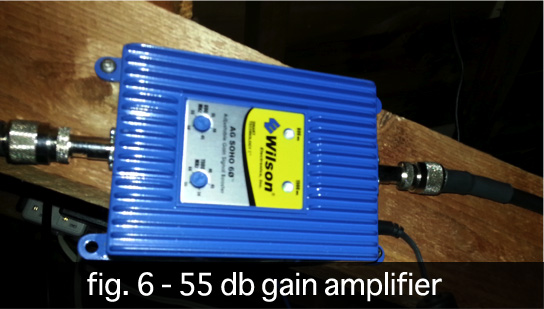 With all the RF cables firmly connected, it's fourth dimension to power up the amplifier. The amplifier's lights will initially start blinking greenish, and in xv minutes they should stay solid if all is working correctly. If you don't become solid green lights, consult the amplifier's troubleshooting guide, but for me, the first attempt gave me all green lights!
With all the RF cables firmly connected, it's fourth dimension to power up the amplifier. The amplifier's lights will initially start blinking greenish, and in xv minutes they should stay solid if all is working correctly. If you don't become solid green lights, consult the amplifier's troubleshooting guide, but for me, the first attempt gave me all green lights!
One time powered up, information technology's fourth dimension for the terminal step: aligning the antenna for maximum reception. Although the bars on a prison cell phone can be useful for casually gauging reception, they lack accurateness and simply update once every 30 seconds to 2 minutes depending on the brand. However, every mobile phone has a subconscious test mode that volition update the signal strength every second. Many of these codes can exist found from searching on Google for "<insert mobile brand name> exam mode codes". You'll be looking for the dial sequence to input in society to access the test manner.
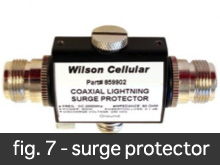 Later inbound your code, select UMTS, debug, and basic. The central numbers are RSCP (received strength coded ability) and Ec/lo which is a ratio of good energy over bad free energy akin to a signal to dissonance ratio. Getting an Ec/lo of -10db and higher (meaning less negative) is ideal. While watching the RSCP number, plough the antenna a couple of degrees and and then wait for the numbers to update. At that place volition be a place where RSCP and Ec/lo maximize themselves, which represents your optimal direction. At this indicate, you're done!
Later inbound your code, select UMTS, debug, and basic. The central numbers are RSCP (received strength coded ability) and Ec/lo which is a ratio of good energy over bad free energy akin to a signal to dissonance ratio. Getting an Ec/lo of -10db and higher (meaning less negative) is ideal. While watching the RSCP number, plough the antenna a couple of degrees and and then wait for the numbers to update. At that place volition be a place where RSCP and Ec/lo maximize themselves, which represents your optimal direction. At this indicate, you're done!
Past now your remote location should have awesome 3G/4G prison cell and data coverage, enabling y'all to leverage some of today'south technological niceties. For instance, I can at present control and monitor the heating in my cabin, right from my cell phone. As I bulldoze upwardly to the motel in winter (half-dozen months in Canada), I bring up the app on my telephone and turn the estrus on so information technology's prissy and cozy when I arrive. There are lots of advantages to having a stable information signal that we could go into, simply of course, that is another blog entry all by itself.
Have any questions on how I did it? But ask in the comments box beneath.
[Before beginning any project to heave your wireless signal as Al describes in a higher place, exist certain to inquire the manufacturer of the cellular amplifier about local regulations for both your wireless provider and your local expanse. For example, in the U.S. the FCC recently adopted rules to ensure the reliability of private cellular networks by having people operating cellular signal boosters register them with their mobile provider. No such rules exist in Canada at the fourth dimension this was published.]
How Far Underground Can You Get A Cell Service,
Source: https://www.ciena.com/insights/articles/How-I-built-my-own-mobile-cell-tower-prx.html
Posted by: rosaalent1945.blogspot.com


0 Response to "How Far Underground Can You Get A Cell Service"
Post a Comment